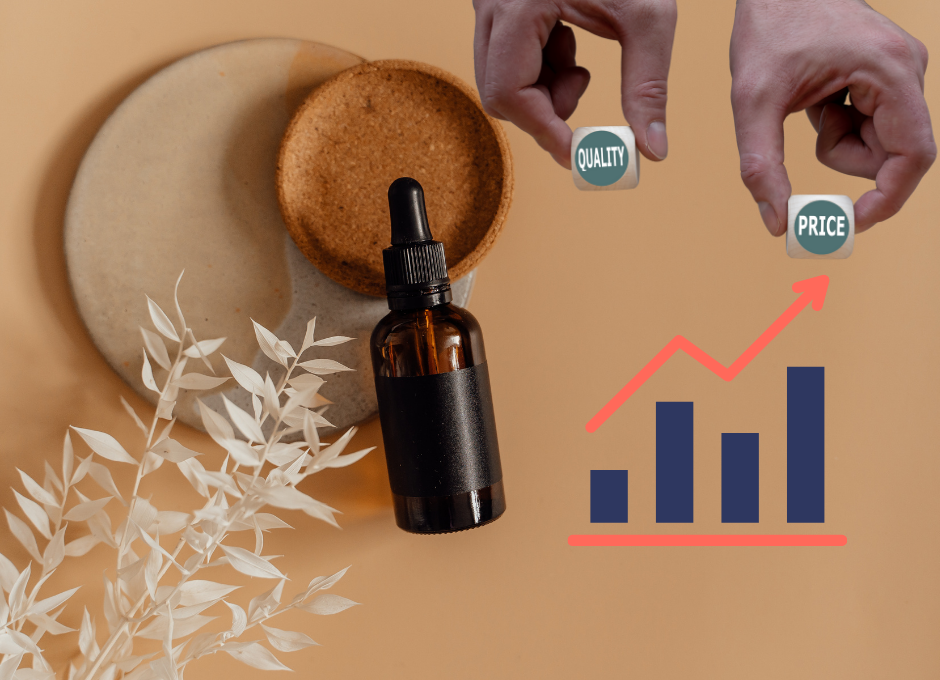Developing pricing strategies in the cosmetic industry involves a nuanced understanding of various costs, market competition, and consumer demand. Here’s a detailed look into each aspect with specific examples from the cosmetic sector (More Naturals) (Beauty Biz Jnl) (McGraw Hill) (440 Industries) (Snipp) (PriceBeam).

Direct Costs: These are the costs directly associated with the production of your product. In the cosmetics industry, direct costs include ingredients (such as essential oils, pigments, and preservatives), packaging (bottles, jars, labels), and direct labor costs for those involved in the manufacturing process. For example, producing an organic skincare line may involve higher direct costs due to the premium price of organic ingredients and specialized eco-friendly packaging.
Indirect Costs: These costs are not directly linked to production but are necessary for the overall functioning of the business. This includes marketing expenses, salaries for administrative and sales staff, rent for office or retail space, and utilities. A cosmetics brand might incur substantial indirect costs in branding efforts and influencer partnerships to create a strong market presence.
Break-Even Point: This is the point at which total revenue equals total costs, meaning the business is not making a loss but is not profitable either. For instance, if the cost to produce a moisturizer (direct costs) is $5 per unit and the indirect costs (marketing, rent, etc.) add up to $20,000 a month, the break-even point will depend on the chosen price point and how many units must be sold to cover these costs.
In the cosmetics industry, analyzing the competition involves understanding the pricing strategies of similar products in the market. If your brand specializes in vegan makeup, look at how other vegan makeup brands are pricing their products. Consider how your product differs or aligns with these offerings in terms of quality, ingredients, brand prestige, and packaging. This comparative analysis can help you position your product competitively.

Understanding your target market is crucial for setting a price point that reflects the perceived value of your product. In cosmetics, this means considering factors like brand loyalty, the importance of organic or cruelty-free ingredients, and the role of packaging and branding in consumer decision-making. For example, customers may be willing to pay a premium for skincare products that are proven to be effective and come from a brand with a strong ethos on sustainability.

Cost-Plus Pricing: This strategy involves adding a markup to the cost of producing the product. If a lipstick costs $2 to produce, and you want a 50% markup, you’d price it at $3. This method is straightforward but doesn’t always consider market demand or competition.
Value-Based Pricing: This strategy sets prices based on the perceived value to the customer rather than just the cost of production. A luxury cosmetic brand might price its products higher based on brand prestige, packaging, and marketing efforts that position the product as high-end.
Penetration Pricing: To enter a competitive market, brands may initially set a lower price for their new products to attract customers quickly. For instance, a new cosmetics brand might offer an introductory discount on its foundation range to encourage trial among potential customers.
Premium Pricing: This involves setting the price higher than the competition to signal higher quality or luxury status. High-end cosmetic brands often use this strategy to emphasize the quality of ingredients, packaging, or the brand’s prestige.

A successful pricing strategy in the cosmetics industry requires continuous monitoring and adjustment based on market trends, production costs, and consumer feedback. Regularly reviewing your pricing strategy ensures it remains effective and competitive, accommodating changes in costs, market conditions, and consumer preferences (More Naturals) (Beauty Biz Jnl) (440 Industries) (PriceBeam).
Calculating profit margins and ensuring sustainable business growth

Profit margin is a financial metric used to assess a company’s financial health and efficiency at turning sales into profits. It’s calculated by dividing net income by revenue. In the cosmetics industry, understanding and optimizing profit margins can be complex due to varying costs of goods sold (COGS), which include the cost of ingredients, packaging, and manufacturing.
Example: If your cosmetic company generates $100,000 in sales and the COGS are $60,000, your gross profit would be $40,000. If operating expenses (such as marketing, rent, salaries) are $20,000, your net profit would be $20,000, leading to a net profit margin of 20% ($20,000 net profit / $100,000 revenue).

Sustainable growth involves expanding at a rate that can be maintained without running into financial or operational difficulties. For a cosmetic business, this means carefully managing inventory, investing in marketing wisely, and continuously innovating products to meet consumer demands.

By focusing on these areas, cosmetic companies can navigate the challenges of the industry, from fluctuating ingredient prices and changing consumer preferences to the need for continual innovation. The goal is to build a brand that not only survives but thrives and grows sustainably over time.
Implementing effective pricing adjustments within the cosmetics industry requires a nuanced approach, taking into account market dynamics, competition, consumer behavior, and product lifecycle. Here’s how businesses in the cosmetics sector can navigate these challenges:



In the dynamic cosmetics industry, effective pricing strategies must balance the need for profitability with maintaining a loyal customer base. Brands that successfully implement thoughtful, data-driven pricing adjustments—while staying aligned with consumer expectations and market trends—can enhance their competitiveness and drive sustainable growth.
Summary
In this chapter titled “Understanding Pricing and Profit Margins,” we delve into the process of developing effective pricing strategies within the cosmetics industry. This journey begins with a thorough examination of the various costs associated with producing cosmetic products, encompassing both the direct costs—such as ingredients, packaging, and labor—and the indirect costs, which include marketing efforts and operational expenses. The goal is to pinpoint the break-even point, ensuring that the pricing not only covers these costs but also positions the products competitively in the market.
A crucial part of setting a pricing strategy is the analysis of competition. This requires a deep dive into how similar products are priced and understanding the factors that contribute to their market positioning. By comparing your products in terms of quality, ingredients, and brand value, you can strategically position your own offerings to attract your target market.

Understanding the customer plays a pivotal role in pricing. The right price point reflects the perceived value of the product to the customer, taking into account factors such as brand loyalty and preferences for organic or cruelty-free ingredients. This section emphasizes the importance of aligning prices with what customers value most about your products.
We then explore various pricing strategies, including cost-plus pricing, value-based pricing, penetration pricing, and premium pricing. Each of these strategies has its merits and challenges, and the choice depends on the brand’s market position, objectives, and the perceived value of the products to the customers.
Adaptability is key in the dynamic cosmetics market, necessitating regular reviews and adjustments to the pricing strategy based on market trends, cost changes, and consumer feedback. This agile approach ensures that the pricing strategy remains effective and competitive over time.
The chapter also included calculating profit margins, an essential indicator of the company’s financial health and operational efficiency. By analyzing profit margins, businesses can assess the profitability of their products and make informed decisions to ensure sustainable growth. This involves managing inventory effectively, making wise marketing investments, and continuously innovating products to meet consumer demands.
This comprehensive approach to understanding pricing and profit margins equips businesses with the knowledge to develop pricing strategies that not only reflect the true value of their products but also support sustainable business growth in the competitive cosmetics industry.
Tips and Tricks

